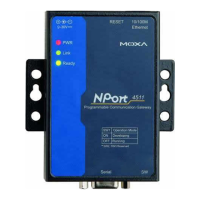MGate MB3000 User’s Manual Configuring the Modbus Gateway
How Slave IDs are Mapped on the MGate MB3000
When a Modbus master requests information from a Modbus slave, the request is addressed to the
desired slave's ID, which must be unique on the network. When Modbus networks are integrated by
a Modbus gateway, complications can arise if the same slave ID is being used on different networks.
If this is not properly addressed, a request sent to that slave ID would receive more than one response,
causing communication problems.
With the MGate MB3000, this situation is addressed by using a slave ID map. While configuring the
MGate, users set up a range of "virtual" slave IDs that are mapped to slave devices on a specific
Modbus network. To send a request to a slave that is on a different Modbus network, a master would
address the request to the appropriate virtual slave ID. The MGate then routes that request as
specified by the slave ID map.
For example, if a TCP master needs information from an ASCII slave, it addresses the request to the
corresponding virtual slave ID as defined on the MGate's slave ID map. The MGate identifies the
request as within its virtual slave ID range and forwards the request to the Modbus ASCII network,
this time addressed to the device's actual slave ID.
Virtual slave IDs must not conflict with each other or with other TCP slave IDs.
The MGate MB3000 will disregard any request that is not addressed to a virtual slave ID on its
slave ID map. If a device has not been assigned a virtual slave ID, it will not be accessible by
masters on the other side of the Modbus gateway.
With the slave ID map, smart routing is achieved for units with multiple serial ports. Since each
virtual slave ID is routed to a specific Modbus network, requests are not broadcast over all serial
ports. This keeps communication efficient and prevents devices on one port from slowing down the
whole system.
How Slave ID Map is Defined
The slave ID map consists of entries (channels) that specify a range of virtual IDs, the destination,
and the offset value. The offset value is used to convert the virtual ID to the actual ID.
Virtual Slaves ID Range
(numeric range from
1 to 254)
This specifies the range of IDs that will be
routed to the selected set of slave devices.
For example, you can specify that IDs
between 8 and 24 be routed to the devices
on Port 3. The ID 255 is reserved for the
Slave ID Offset
(number between
-253 and 253)
This specifies the difference between the
virtual slave ID and the actual slave ID.
slave's virtual ID is 16 and the actual ID is
5, you would set the offset to -11. This
offset is applied to the entire range of
When a serial port is set to RTU slave or ASCII slave mode, a virtual ID range will already be
created for you. Simple select the entry in the table and modify the range and offset as needed. For
TCP slaves, you can add an entry that assigns a range of virtual IDs to a specific IP address, using the
Remote TCP Slave IP setting.
